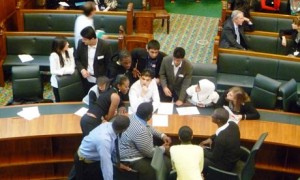Share it
It is just over a year since the new UK supreme court flung open its Magna Carta emblazoned, see-through doors. Sadly the one judge perhaps most responsible for its existence – Lord Bingham – has not lived to see its first birthday. But many others have. One of the court’s major aims was that, by moving from an obscure corridor in the House of Lords into a separate and purpose-designed building, the public would finally get to grips with the work of the UK’s most senior judiciary.
They are getting there. There have been almost 50,000 visitors to the court since it opened last October, and around 200 school and student visits. That doesn’t compare hugely favorably with other visitor attractions – the houses of parliament which receives almost 20 times as many visitors with around 1 million per year – at the moment the supreme court’s numbers are more on a level with Woburn Abbey or Sudley House in Liverpool.
But the vision was not so much about mass tourism, and more about making important judicial decisions accessible. And important decisions there have been: the finding that gay asylum seekers cannot be expected to suppress aspects of their sexuality to avoid persecution, that that a control order requiring a terrorist suspect to live in the Midlands 16-hour curfew was a violation of his rights, and the JFS case, in which the court ruled that a Jewish school had discriminated unlawfully on grounds of race.
Today Lord Phillips, the court’s first and so far only president, said that decision was the hardest of his judicial career. “The JFS case was interesting, very difficult intellectually, and we all disagreed,” said Phillips. “The 9-panel court was split 5/4 and I was in the majority. I think that was hardest decision I’ve had to make.”
Phillips was speaking to around 30 students from Leyton sixth form college. It’s always a joy to see senior legal figures interviewed by young people, because they ask the questions that journalists either wouldn’t think of asking, or wouldn’t dare.
Among other gems was the question “you started at the bottom of the legal profession – how did you work your way up?”. Phillips’ response was the simple, and not overly helpful: “I got here through good luck!”
“I didn’t want to be a judge,” Phillips insisted. “I was very casual in my attitude, I didn’t have ambition. But I was invited by the Lord Chief Justice to become a judge, and in those days you didn’t refuse.”
That was news to me, but maybe that’s not surprising – I can’t imagine any journalist would have got quite the same answer to that question. All credit to the supreme court for opening itself up to young people, and for taking it seriously enough that the justices have made the effort to attend sessions and answer students’ question.
Today Phillips was observing the Leyton law students debating the question of whether the law should allow schools to manage the cultural and religious dress of their students. The debate saw several young women wearing hijabs arguing that if you come to the UK, you should be prepared to observe UK dress codes, and several young men arguing that religious wear such as the ankle-length jilbab makes women feel they are preserving their dignity, and is an expression of individuality and belief with which no institution has the right to interfere. They flipped things on their head, picking up sophisticated arguments about the distinction between religious necessity and cultural practice, and the requirement of reasonableness on public bodies.
But best of all, they looked at the place through new eyes. “Who’s that?” one student asked, pointing to a very large painting of a random member of the eighteenth century aristocracy on the wall. “And why does his painting have such an expensive frame?”
Excellent questions, all of them.
This post originally appeared on Afua Hirsch’s Law Blog and is reproduced with permission and thanks.



